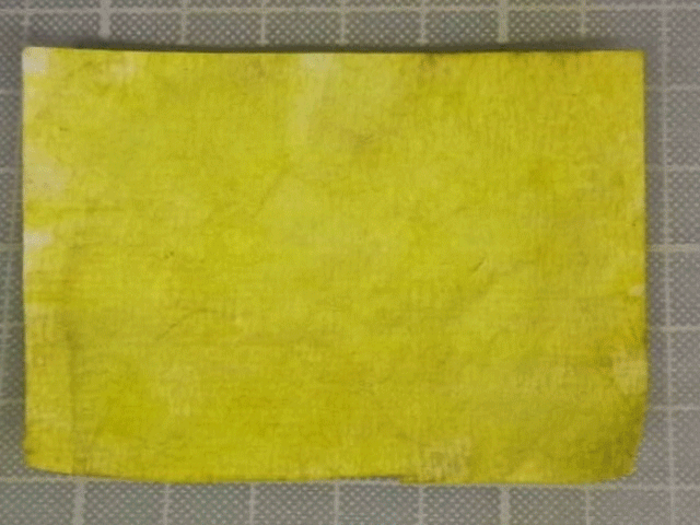A study on a pressure-sensitive material called fluorenylidene-acridane (FA) was published by researchers from Nagoya University in central Japan in the Journal of Materials Chemistry. Technologies involving pressure sensing, recording, and display devices could benefit from this novel material.
 A thin film of FA changes its color in response to pressure. Applying alcohol turns the color back to yellow. Image Credit: Dr. Yutaka Matsuo
A thin film of FA changes its color in response to pressure. Applying alcohol turns the color back to yellow. Image Credit: Dr. Yutaka Matsuo
Mechanochromic materials alter their color in response to outside factors like mechanical pressure. Prior studies on mechanochromism, however, were limited to qualitative reports, such as whether the color altered. Quantitative analysis was missing until now.
A study team at the Department of Chemical Systems Engineering, Graduate School of Engineering, Nagoya University, under the direction of Professor Yutaka Matsuo, examined FA, a mechanochromic material, to quantitatively explain the color change.
They conducted multiple tests on materials containing FA and discovered that when touched, it turned from yellow to dark green. Yet, unlike previous mechanochromic materials, it altered color by absorbing light as opposed to emitting it. This is what makes the material so special.
FA’s mechanochromic activity was only previously seen in powder form. However, to carry out the subsequent measurements for their current investigation, the research team first created a thin FA film. The researchers then used measurement methods known as diffuse reflectance ultraviolet–visible (UV–vis) spectroscopy to calculate color changes.
In addition, they employed Kelvin force microscopy to indirectly assess the structural alterations of FA. The color slowly turned green as the mechanical pressure increased from yellow to green. Moreover, the FA structure altered more depending on the amount of pressure that was applied.
The quantitative relationship between mechanical pressure and the degree of color change in an FA-containing substance was made clearer by these results. This is the first time that FA has used quantitative data.
The tests carried out by the researchers also showed that FA has a high spatial resolution. The FA film’s spatial resolution was 1000 times greater than that of other pressure-sensing films that are already on the market and could detect the pressure exerted over a width as small as 50 nm.
Additionally, the film’s color returned to yellow after being exposed to ethanol. This is significant because earlier research had only employed powerful solvents, like chloroform, to reverse the color shift. Now, however, widely available solutions such as alcohol can be used in combination with this technology.
Quantitative measurement of FA opens up a load of opportunities for technologies like disc storage.
Optical disc devices, such as CDs and DVDs, use laser light to write data. We could utilize color changes after mechanical pressure to store information.
Yutaka Matsuo, Professor, Department of Chemical Systems Engineering, Graduate School of Engineering, Nagoya University
Aside from FA, other types of mechanochromic materials could also be measured using the methods from this study. This suggests that this discovery could also help with current and future pressure sensor technology studies.
Finally, the color of a material surface can indicate whether it has been touched and whether it has been cleaned with alcohol. This could have an impact on how thoroughly the surfaces are cleaned.
Imagine, for instance, a table that could change color when it has been touched and contaminated and then changes to a different color when it has been wiped clean. This technology would be useful in a hospital setting that aims to limit the spread of disease through contact with infected surfaces.
Journal Reference:
Ogumi, K., et al. (2022) Quantitative and high-resolution mechanical pressure sensing functions of mechanochromic fluorenylidene-acridane. Journal of Materials Chemistry C. doi:10.1039/D2TC01988D.